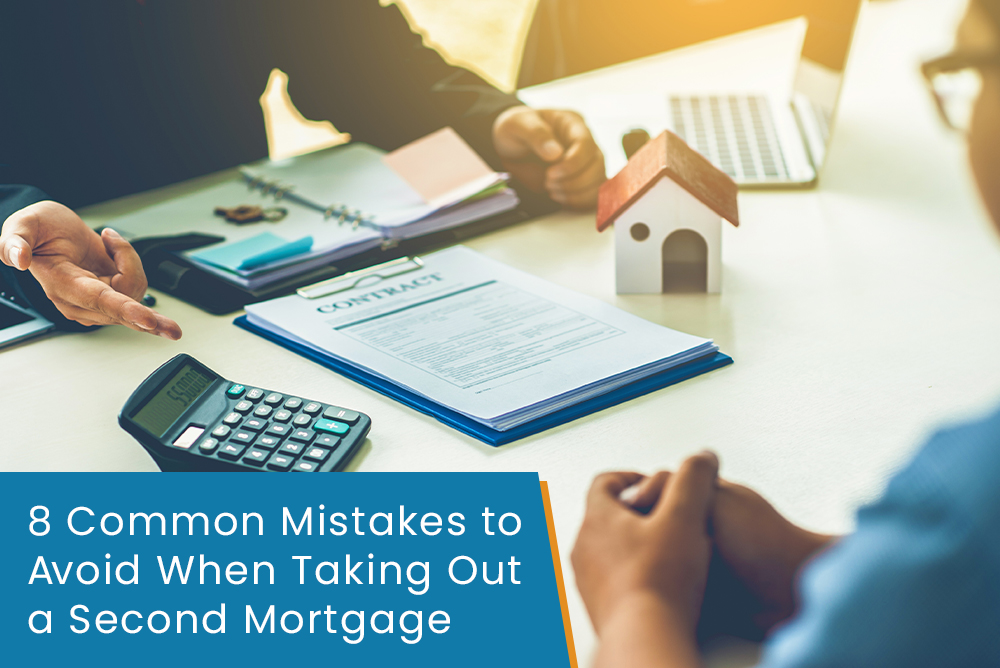
8 Common Mistakes to Avoid When Taking Out a Second Mortgage
Tags:
There are several reasons to take on a second mortgage on your home. It could be to have an investment property or vacation home, make home improvements, or even consolidate debt. Taking a second mortgage can be challenging because of the rules and regulations involved. It can also be difficult to handle paying two mortgages simultaneously.
However, if you have decided to take out a second mortgage, there are a few essential elements to remember and common mistakes to avoid. Before getting into the mistakes people typically make when taking out a second mortgage, let’s discuss what exactly a second mortgage is.
What Is a Second Mortgage?
Simply put, a second mortgage requires getting additional financing on top of the pre-existing mortgage for the same property. It means taking out a second loan on your mortgaged house to get finances for various purposes like consolidating debt, having a vacation home or a second home when your children need it, or even making home improvements.
The finances issued to you are against the equity built up on your first mortgage. Financial institutions issue second mortgages in two forms: a home equity line of credit (HELOC) or a home equity loan.
A HELOC allows you to borrow money up to a specified amount. Most major banks approve a HELOC if the homeowner has good credit with 20% or more equity. On the other hand, a home equity loan is a lump sum given to you that needs repaying over a fixed term. It is a one-time loan which can be ongoing.
Common Mistakes to Avoid When Taking Out a Second Mortgage
1. Not doing proper research.
Before making any decision—especially one as big as a second mortgage—you should research and gather information on your options. This should include the different mortgage providers, the state of the real estate market, the area in which you wish to purchase your second property, property taxes, and more.
Only after gathering all this information can you make an informed decision.
2. Not taking a realistic look at your finances.
As part of your research, you must look at your finances and ensure you can afford to make two mortgage payments simultaneously. Making two sizable payments can be challenging. Furthermore, there are grave consequences for defaulting, for example, not being able to make payments.
Review your budget and finances, and speak with a financial advisor to better understand your situation. Discuss the details with the mortgage lender as part of your second mortgage application process.
3. Not having a money management plan.
If taking on a second mortgage is to consolidate debt, you must have a strong money management plan beforehand. Consolidating debt means taking on a bigger loan to pay off smaller debts. It means you must understand how you got into debt and address the root of the problem.
A second mortgage can become a burden if a strong money management plan is not in place.
4. Not paying attention to your credit score.
Another mistake that people make is neglecting their credit score. Even though you will be taking out your second mortgage based on the equity in your home, you need to pay attention to your credit score as well.
Your credit history is still a crucial factor when securing a second mortgage. Review your credit report and take steps to improve it before applying for a second mortgage.
5. Not getting pre-approval.
Getting pre-approved for your second mortgage is an important step. It will let you know what kind of mortgage you can get, which will help you determine the investment type you can make. A preliminary evaluation can bring pre-qualification offers. You can find out your estimated interest rate and your maximum principal amount.
However, your credit score will come into play when getting pre-approval.
6. Not choosing the right mortgage provider.
If you already have a mortgage provider for your current property, you will likely use the same one for your second mortgage. It is a common occurrence. While not always a mistake, it can be in some cases.
It is convenient to go to someone you have worked with before. However, in the case of a second mortgage, you should shop around. Don’t be afraid to explore other options or even consider a private mortgage lender if you don’t have one already.
7. Ignoring additional costs during budgeting.
If you want to purchase another property with a second mortgage, you must consider the additional costs involved, like furnishing the home, insurance, maintenance of the second property, and more. These should be accounted for when budgeting for a second mortgage.
8. Going for the lengthiest term for monthly payments
People often go for the lengthiest term for their monthly mortgage payments because it is a lower amount. However, long-term payments incur more interest over the tenure of the loan, which can be significantly more expensive.
While this increased cost is often covered with gradually increasing finances, taking on a loan for a shorter duration may cost you relatively less over the long run.
Final Thoughts
There could be various reasons for taking out a second mortgage, so the responsible way to go is to be well-informed, have a money management plan, and choose the right mortgage provider. Our specialists can help you avoid the common mistakes that people make when taking out a second mortgage.
For more information about second mortgages or to start your application, call Canadalend at 1-844-586-0713 or contact us here.